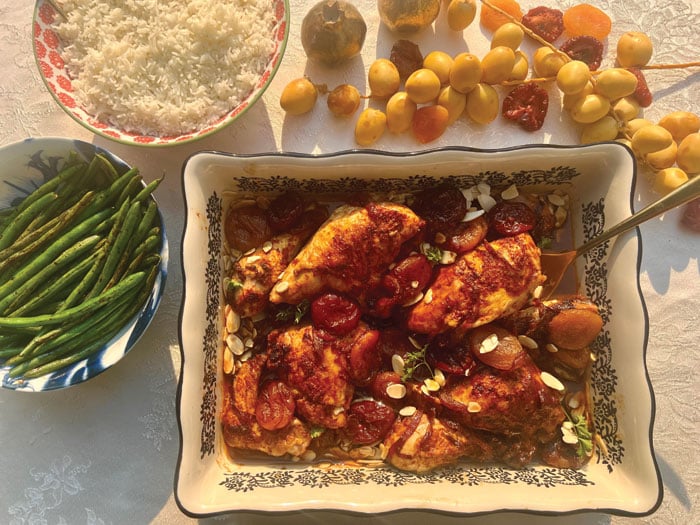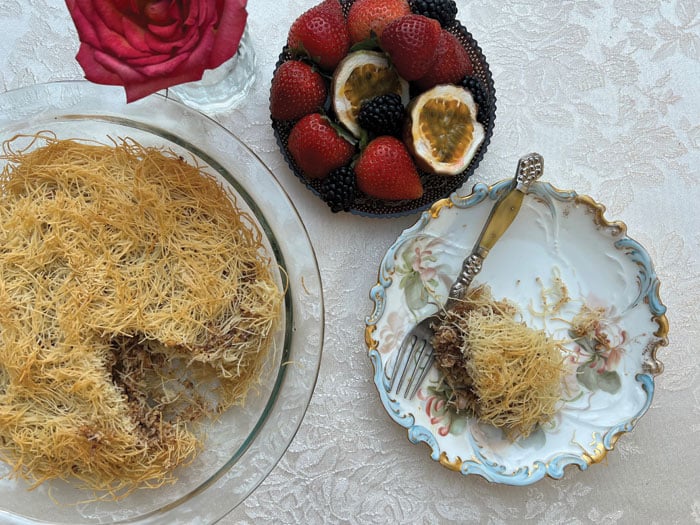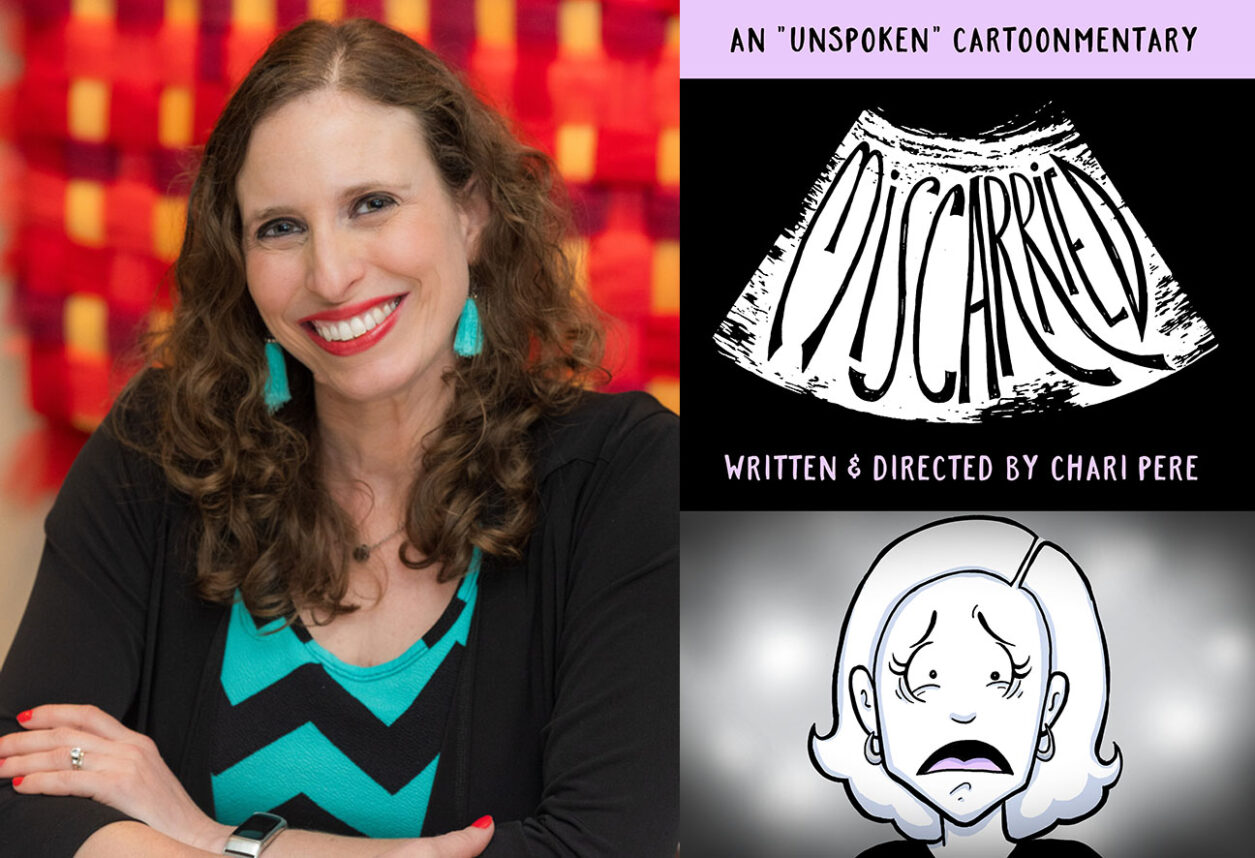 Photos by Alexandra Gomperts
Photos by Alexandra Gomperts When my family moved from Morocco to America, my mother managed to keep all the old traditions alive through the years. Rosh Hashanah for my mother meant lots of baking. She made honey cookies, sponge cakes and the most exquisite date and almond cigars. Unfortunately, these cigars are one of the lost recipes because I never paid attention when she made them. They were not made with the typical phyllo dough or Moroccan brik (egg roll style) sheets. She would mix her own dough, stuff with soft dates and ground almonds, roll into cigars, fry the cigars and in a final act of decadence, dip them in a honey syrup. The delicious memory lives on.My tireless Maman would peel and chop thick-skinned quince and stand over the hot stove, until she had the sweetest, prettiest pink quince jam for the Rosh Hashanah Seder table.
As for the rest of the simanim, (leeks, spinach, gourds etc) she would boil them in a soup and drizzle honey on them. Yuck! We weren’t quite as fond of that. (She would also make a flavorful soup with beef bones and all of the vegetables that make up the simanim.) There would be a table filled with bowls of Moroccan salads, along with her standout, perfectly seasoned, creamy chicken liver pâté (chopped liver). The main course would be couscous, with lamb and chicken, vegetables and stewed fruits, representing happiness and abundance, prosperity and blessing.
I have no idea how she made all this and ran her own business.
Rosh Hashanah meant wearing a new dress to synagogue. My mother would call it Estrenar (in Spanish it means to wear something new.) We attended services at Sephardic Temple Tiffereth Israel and we sat in the Moroccan section with Racquel Bensimon and her family in front of us. Behind us would sit the Sephardic Education Center’s very own Rabbi Daniel Bouskila, his sisters, Sylvie and Orly, his father Nessim from Marrakesh (the head tailor in the wardrobe department for Aaron Spelling Productions) and his mother Alice from Oran, Algeria.
During breaks in the service, we would have so much fun telling funny stories in French and just laugh and laugh.
After a long day of prayer, we would come home and eat tortilla de pattata and lots of salads. We never took a nap on Rosh Hashanah, so that we would have a productive year and not be sleeping all year.
Growing up, I was always by my mother’s side in the kitchen, learning tricks and tips. She always set a beautiful table and I follow her example, always setting a table with fine linens and cloth napkins, my finest chinaware, my silver and my crystal. Fresh flowers and candelabra with lit candles. I do as my mother did, I take it all out and use it. What should we save it for, if not these occasions!?!
Pour your love into everything you make because your family and guests will taste it with every bite. Food memories are the most special and awaken so much emotion in our hearts.
—Rachel
Djaje Bi Mishmash
Chicken with dried fruits
About five years ago, Alan and I traveled to Panama to have a romantic getaway for the other New Year. We loved it so much and felt so guilty for not bringing our children (they had school that week), we brought them to Panama two years later.
Panama is a tiny nation filled with stark contrasts and incredible wonders. Panama City, which nestles the Pacific Ocean, is filled with Manhattan-style skyscrapers and jungle vegetation. You can spend the day with the man-made ingenuity and wonder of the Panama Canal. You can feed the wild and cheeky capuchin and tamarin monkeys on Monkey Island. You can take a catamaran to the Pearl Islands and laze on the most stunning white sand beaches. You can drive from the Pacific Ocean, and a mere 45 minutes later, find yourself at the Atlantic Ocean, where you will see old Spanish fortresses and stunning, colorful tropical fish in the warm blue sea.
Of course, when you’re Jewish it’s all about the food. And in Panama City you are in luck. The Jewish community emigrated there from Syria starting in the 1820s and is an integral part of the country’s political, finance, construction, tourism and textile sectors. Put it this way, when you enter the exhibit adjacent to the Panama Canal, you can kiss the mezuzot on the doors and eat empanadas at the strictly kosher Coffee Bean.
For a city that boasts a Jewish population of 15,000, the selection and quality of the kosher restaurants is astounding. And the two kosher supermarkets are both the size of a small town, with countless options. As a Sephardic Spice Girl, I was intrigued by all the spices and other exotic ingredients available. You could just feel the incredible traditional Syrian cooking coming out of those high rise kitchens. Inspired, I brought home “kubbah” spices and packages of tamarind. We returned to Los Angeles and made lots of delicious lach’majin, ground beef flavored with with tamarind on a flatbread (Trader Joe’s pizza dough works fabulously for this recipe).
Tamarind is the sweet and tart secret ingredient of the Syrian kitchen. When Rachel found this fabulous recipe for chicken with dried apricots in the Syrian/Mexican cookbook “Sefre Dayme,” I was all in.
We adapted the recipe by adding red onions and dried plums and subbing silan for the honey. The chicken was perfectly sweet and sour, moist and tender.
—Sharon
3 to 4 pounds chicken, cut into 10 pieces
1 large red onion
¼ cup olive oil
2 cups orange juice
½ cup tamarind paste
1/3 cup silan (date syrup)
1 teaspoon paprika
Salt to taste
½ teaspoon white pepper
½ cup dried apricots
½ cup dried plums
1/2 cup water
1/3 cup toasted peeled slivered or whole
almonds, for garnish
- Preheat oven to 350°F.
- In a medium bowl, whisk tamarind paste, orange juice, silan (date syrup), paprika, salt and pepper, then set aside.
- In an oven safe skillet, warm the oil over medium low heat and sauté the onions until golden, about 8 minutes.
- Add the chicken pieces skin side down and sauté for 3 minutes, then flip the pieces.
- Add the dried fruits, tamarind sauce and water to the skillet.
- Cover with foil and bake for one hour. Uncover and bake for an additional 15 minutes.
- Remove from oven and transfer to a serving platter, then add the toasted almonds.

CHICKEN LIVER / PATE AU FOIE
I’ve been eating pate au foie all my life. My mother’s pate was legendary, melt in your mouth heaven. As a I child I got excited knowing it was on the table. I don’t ever recall a holiday without it. I started making it when I got married. My husband asked me to add caramelized onions, chopped parsley and hardboiled egg, so it became “chopped liver.”
Nowadays I only make it several times a year, but always for Passover and Rosh Hashanah. Of course, my kids won’t touch it. What is it about being born in America that makes them dislike liver? Regardless, you will always find it on my table.
—Rachel
3 pounds chicken liver
1 tablespoon kosher salt
3 medium onions, thinly sliced
¼ cup extra virgin olive oil
1 stick (8 tablespoons) Miyokos Vegan Butter, or margarine or schmaltz
2 medium carrots, peeled and sliced
4 large bay leaves
1 cup chicken broth or water
¼ cup cognac or white wine
Juice of one lemon
2 teaspoons white pepper
Salt to taste
- Drain all visible blood from the chicken livers, then place on a baking sheet lined with foil or parchment paper.
- Sprinkle with 1 tablespoon kosher salt, making sure each chicken liver is salted.
- Place in broiler for 5 minutes. Remove from oven and drain all juices.
- In a large pan, sauté onion in olive oil until it becomes soft and slightly golden, about 10 minutes.
- Add the vegan butter, carrots, bay leaf, chicken broth, white pepper, livers and cognac or white wine.
- Reduce heat, cover and allow to simmer until liver is soft and juices are reduced and thick, about 20 minutes.
- Remove the bay leaves.
- Remove from heat and let cool 10 minutes.
- Pour into a food processor and whip for 3 minutes or until very smooth. Pulse if a chunky texture is preferred.
- Add lemon juice and process a few more seconds.
- Taste and adjust salt or pepper.
- Refrigerate overnight, or freeze in a well-sealed container.
For Chopped Liver
Add caramelized onion, finely chopped parsley and chopped hard boiled egg.

Pecan Knafe
Along with wonderful memories and precious photos, Neil and I returned from our summer trip to Istanbul with a love for Knafeh. Knafeh is a popular Middle Eastern dessert made with thin, crunchy filaments of shredded Phyllo pastry called kataifi. It is typically layered with cheese and nuts and soaked in a sweet orange blossom or rosewater scented syrup.
Along with wonderful memories and precious photos, Neil and I returned from our summer trip to Istanbul with a love for Knafeh.
I was inspired to make knafeh and film it for an Instagram reel and we had an incredible response. Estrella, my daughter-in-law, told me that her Syrian Jewish family makes a pareve verision of knafeh. Her mother Denisse, originally from Guadalajara but now living in Miami, makes her version of Knafeh with pecans every Rosh Hashanah.
Intrigued, I turned to my trusty Syrian cookbook, “Sefra Dayme”.
(In the 1980’s, my husband Neil led many memorable Hamsa summer trips for the Sephardic Educational Center. Among the many teen participants from Mexico City was Elias Harari. Years later when his son came to Los Angeles to study at USC, we had the pleasure of hosting him at our home on many Shabbats. When Elias and his lovely wife Rebecca Uziel came to visit us for the first time, she brought me this beautiful cookbook.)
“Sefra Dayme: Cien anos de cocina Judeo-Damasquina en Mexico” (One hundred years of the Jewish Damascene kitchen in Mexico) was written in Spanish by Amelia Romano de Salame. It is a love letter filled with traditional recipes that originated with the Jewish community of Damascus, Syria.
The inside flap of the book wishes the reader “May you always have a table of abundance, blessed food, a table filled with joy.”
So I asked Estrella’s grandmother Telly to explain what Sefra Dayme literally means. Do they as a Syrian family use this expression? She sent me a WhatsApp message explaining how to use this saying.
As a guest at someone’s home for dinner, after enjoying the food, you will compliment the hostess by saying “Sefra Dayme,” everything was delicious. She will respond “Awafi,” may it be good for you. (In Spanish, buen provecho. In French, bon apetit. In Hebrew, b’te’avon.)
Anyway, this recipe for Knafeh with its layers of crispy thin filaments of pastry, pecans and orange blossom syrup is just heavenly — honeyed, crunchy and nutty.
A perfect dessert for a sweet Rosh Hashanah.
– Rachel
Miel Arabe (Arabic Honey Syrup)
1/2 cup water
1 cup sugar
½ lemon, juiced
1 teaspoon ground cinnamon (optional)
1 tablespoon orange blossom water (or rosewater)
- In a small saucepan, bring water to a boil over medium heat. Add sugar and stir until sugar has melted.
- Add lemon juice, cinnamon and orange blossom water and stir well.
- Set aside to cool for at least one hour, so that the syrup thickens.
1 16 ounce package of Kataifi pastry
8 ounces vegan butter, melted
1 cup of sugar
2 cups chopped pecans
1 teaspoon ground cinnamon
1 cup Arabic honey syrup
- Preheat oven 350°F.
- In a large bowl, separate kataifi strands so that they are loose and fluffy. Add melted vegan butter and mix well. Set aside.
- In a separate bowl, mix the sugar, ground pecans and cinnamon.
- Place half the pastry into a greased baking pan or glass pie dish. Sprinkle nut mixture evenly over the pastry. Cover with the remaining strands of pastry.
- Bake for 40 minutes or until pastry appears golden and crunchy. Remove from oven drizzle with Arabic honey syrup.
Notes:
Miyoko’s Creamery Butter is our favorite vegan butter.
Any nuts you love will work in this recipe: almonds, walnuts, pistachios.
All spices and flavored waters are optional.
Sharon Gomperts and Rachel Emquies Sheff have been friends since high school. The Sephardic Spice Girls project has grown from their collaboration on events for the Sephardic Educational Center in Jerusalem. Follow them on Instagram @sephardicspicegirls and on Facebook at Sephardic Spice SEC Food. Website sephardicspicegirls.com/full-recipes






















 More news and opinions than at a Shabbat dinner, right in your inbox.
More news and opinions than at a Shabbat dinner, right in your inbox.